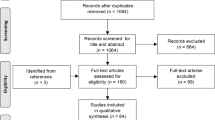Abstract
Experimental data suggests that tissue-specific progenitors are present within hyaline articular cartilage with the potential to contribute to growth, maintenance, and repair. In this chapter, we show how colony-forming progenitor-like cells can be isolated from bovine articular cartilage using differential adhesion to fibronectin. Furthermore, we describe the optimal conditions and factors required to differentiate these progenitor cells to produce hyaline articular cartilage.
Access this chapter
Tax calculation will be finalised at checkout
Purchases are for personal use only
Similar content being viewed by others
References
Hunziker EB (2009) The elusive path to cartilage regeneration. Adv Mater 21(32–33):3419–3424
Benya PD, Shaffer JD (1982) Dedifferentiated chondrocytes reexpress the differentiated collagen phenotype when cultured in agarose gels. Cell 30(1):215–224
Dell’Accio F, De Bari C, Luyten FP (2001) Molecular markers predictive of the capacity of expanded human articular chondrocytes to form stable cartilage in vivo. Arthritis Rheum 44(7):1608–1619
Passaretti D et al (2001) Cultured chondrocytes produce injectable tissue-engineered cartilage in hydrogel polymer. Tissue Eng 7(6):805–815
Dowthwaite GP et al (2004) The surface of articular cartilage contains a progenitor cell population. J Cell Sci 117(Pt 6):889–897
Alsalameh S et al (2004) Identification of mesenchymal progenitor cells in normal and osteoarthritic human articular cartilage. Arthritis Rheum 50(5):1522–1532
Li Y et al (2016) Intermittent hydrostatic pressure maintains and enhances the chondrogenic differentiation of cartilage progenitor cells cultivated in alginate beads. Develop Growth Differ 58(2):180–193
McCarthy HE et al (2012) The comparison of equine articular cartilage progenitor cells and bone marrow-derived stromal cells as potential cell sources for cartilage repair in the horse. Vet J 192(3):345–351
Neumann AJ et al (2015) Human articular cartilage progenitor cells are responsive to mechanical stimulation and adenoviral-mediated overexpression of bone-morphogenetic protein 2. PLoS One 10(8):e0136229
Tong W et al (2015) In vivo identification and induction of articular cartilage stem cells by inhibiting NF-kappaB signaling in osteoarthritis. Stem Cells 33(10):3125–3137
Williams R et al (2010) Identification and clonal characterisation of a progenitor cell sub-population in normal human articular cartilage. PLoS One 5(10):e13246
Xue K et al (2015) Isolation and identification of stem cells in different subtype of cartilage tissue. Expert Opin Biol Ther 15(5):623–632
Shwartz Y et al (2016) Joint development involves a continuous influx of Gdf5-positive cells. Cell Rep 15(12):2577–2587
Rux D et al (2019) Joints in the appendicular skeleton: developmental mechanisms and evolutionary influences. Curr Top Dev Biol 133:119–151
Hunziker EB, Kapfinger E, Geiss J (2007) The structural architecture of adult mammalian articular cartilage evolves by a synchronized process of tissue resorption and neoformation during postnatal development. Osteoarthr Cartil 15(4):403–413
Decker RS et al (2017) Cell origin, volume and arrangement are drivers of articular cartilage formation, morphogenesis and response to injury in mouse limbs. Dev Biol 426(1):56–68
Wagner W et al (2001) Neonatal rat cartilage has the capacity for tissue regeneration. Wound Repair Regen 9(6):531–536
Ribitsch I et al (2018) Fetal articular cartilage regeneration versus adult fibrocartilaginous repair: secretome proteomics unravels molecular mechanisms in an ovine model. Dis Model Mech 11(7):dmm033092
Tew SR et al (2000) The reactions of articular cartilage to experimental wounding: role of apoptosis. Arthritis Rheum 43(1):215–225
Hayes AJ et al (2001) The development of articular cartilage: evidence for an appositional growth mechanism. Anat Embryol (Berl) 203(6):469–479
Salter DM, Godolphin JL, Gourlay MS (1995) Chondrocyte heterogeneity: immunohistologically defined variation of integrin expression at different sites in human fetal knees. J Histochem Cytochem 43(4):447–457
Jones PH, Watt FM (1993) Separation of human epidermal stem cells from transit amplifying cells on the basis of differences in integrin function and expression. Cell 73(4):713–724
Khan IM et al (2009) Clonal chondroprogenitors maintain telomerase activity and Sox9 expression during extended monolayer culture and retain chondrogenic potential. Osteoarthr Cartil 17(4):518–528
Dominici M et al (2006) Minimal criteria for defining multipotent mesenchymal stromal cells. The International Society for Cellular Therapy position statement. Cytotherapy 8(4):315–317
Pittenger MF et al (1999) Multilineage potential of adult human mesenchymal stem cells. Science 284(5411):143–147
Khan IM et al (2011) Fibroblast growth factor 2 and transforming growth factor beta1 induce precocious maturation of articular cartilage. Arthritis Rheum 63(11):3417–3427
Morgan BJ et al (2020) Bone morphogenetic protein-9 is a potent chondrogenic and morphogenic factor for articular cartilage chondroprogenitors. Stem Cells Dev 29(14):882–894
Brown RA, ProQuest (2013) Extreme tissue engineering: concepts and strategies for tissue fabrication. Wiley, Hoboken. 1 online resource (270p)
Ramos-Ibeas P et al (2017) Pyruvate antioxidant roles in human fibroblasts and embryonic stem cells. Mol Cell Biochem 429(1–2):137–150
Author information
Authors and Affiliations
Corresponding author
Editor information
Editors and Affiliations
Rights and permissions
Copyright information
© 2023 The Author(s), under exclusive license to Springer Science+Business Media, LLC, part of Springer Nature
About this protocol
Cite this protocol
Khan, I.M., McKenna, J., Zhang, Y. (2023). Articular Cartilage Chondroprogenitors: Isolation and Directed Differentiation. In: Stoddart, M.J., Della Bella, E., Armiento, A.R. (eds) Cartilage Tissue Engineering. Methods in Molecular Biology, vol 2598. Humana, New York, NY. https://doi.org/10.1007/978-1-0716-2839-3_4
Download citation
DOI: https://doi.org/10.1007/978-1-0716-2839-3_4
Published:
Publisher Name: Humana, New York, NY
Print ISBN: 978-1-0716-2838-6
Online ISBN: 978-1-0716-2839-3
eBook Packages: Springer Protocols




